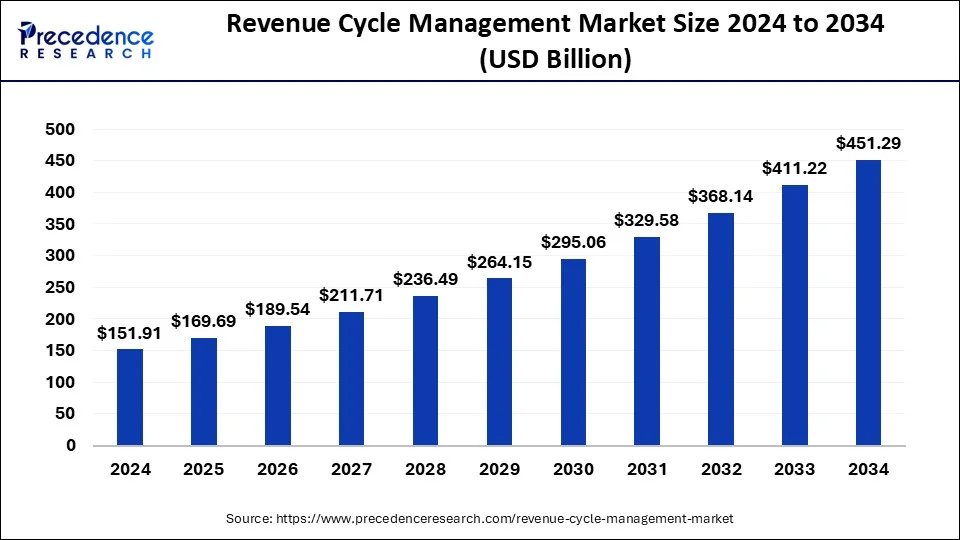The global revenue cycle management market is expected to grow from USD 151.91 billion in 2024 to USD 451.29 billion by 2034, at a CAGR of 11.50%.

Revenue Cycle Management Market Key Takeaways
- In 2023, North America held the largest share of the moisture curing adhesive market.
- The software segment was the leading offering segment in 2023.
- The service offering segment is projected to grow at a significant pace during the forecast period.
- The integrated segment dominated the market by type in 2023.
- Physician offices emerged as the leading end-user segment in the global market in 2023.
Market Overview
The revenue cycle management market is expanding as healthcare providers increasingly seek to optimize financial performance and improve operational efficiency. Revenue cycle management (RCM) encompasses a set of processes and technologies designed to manage the financial aspects of patient care, from initial appointment scheduling and insurance verification to claims submission and payment collection. With rising healthcare costs and regulatory complexities, healthcare organizations are turning to advanced RCM solutions to minimize revenue leakage and ensure timely reimbursement. The adoption of cloud-based RCM platforms, the growing focus on patient-centered care, and the shift toward value-based payment models are contributing to the rapid growth of the revenue cycle management market.
Drivers
The growth of the revenue cycle management market is driven by several key factors. The increasing complexity of healthcare billing and reimbursement processes has created a demand for automated and efficient RCM solutions. The widespread adoption of electronic health records and the integration of healthcare IT systems have further boosted the need for RCM technologies that can seamlessly manage financial operations.
Additionally, the growing emphasis on reducing administrative costs and improving cash flow has prompted healthcare providers to invest in advanced RCM solutions. The increasing trend of outsourcing revenue cycle management services to specialized vendors is also fueling market growth, as healthcare organizations seek to streamline operations and focus on core clinical activities.
Opportunities
The revenue cycle management market offers significant opportunities, particularly with the integration of artificial intelligence, predictive analytics, and machine learning technologies. AI-powered RCM solutions can analyze large volumes of data to identify billing errors, predict payment outcomes, and optimize claims management processes. The rising adoption of telehealth and virtual care services also presents new opportunities for RCM solutions, as these services require robust billing and reimbursement mechanisms. Emerging markets, particularly in Asia Pacific and Latin America, provide growth potential due to increasing healthcare digitization and rising investments in healthcare IT infrastructure.
Furthermore, the transition to value-based care models is driving the demand for RCM solutions capable of managing complex reimbursement structures and ensuring compliance with evolving regulatory requirements.
Challenges
Despite its growth prospects, the revenue cycle management market faces several challenges. The high initial costs associated with implementing RCM systems can be prohibitive for small and medium-sized healthcare providers. Integrating RCM solutions with existing healthcare IT infrastructure can also be complex and time-consuming, requiring specialized expertise and ongoing maintenance. Additionally, frequent changes in payer policies and healthcare regulations necessitate continuous system updates and training, which can add to operational costs. Concerns related to data security and patient privacy are another challenge, as RCM systems handle sensitive financial and personal information that must be protected from potential cyber threats.
Regional Insights
North America leads the revenue cycle management market, driven by the high adoption of healthcare IT solutions, a strong regulatory framework, and the presence of established RCM vendors. The United States accounts for the largest market share, supported by the growing demand for advanced RCM solutions to manage complex billing processes and ensure regulatory compliance. Europe follows closely, with increasing investments in healthcare IT infrastructure and a focus on improving financial efficiency in healthcare operations.
The Asia Pacific region is poised for rapid growth due to rising healthcare expenditures, government initiatives promoting healthcare digitization, and the growing awareness of RCM benefits in countries like China, India, and Japan. Latin America and the Middle East & Africa are also emerging as potential markets, driven by improving healthcare infrastructure and a rising demand for efficient financial management systems.
Recent News
Recent developments in the revenue cycle management market highlight the increasing adoption of cloud-based RCM solutions, AI-powered analytics, and machine learning technologies. Leading RCM vendors are expanding their service portfolios through strategic acquisitions and partnerships to enhance their capabilities and meet the evolving needs of healthcare providers. The growing focus on value-based care and patient-centric payment models is driving the demand for advanced RCM systems capable of handling complex reimbursement structures. Additionally, government initiatives aimed at promoting healthcare IT adoption and improving financial transparency are further contributing to market growth.
Revenue Cycle Management Market Companies
- Cerner Corporation
- McKesson Corporation
- Quest Diagnostics Incorporated
- Allscripts Healthcare Solutions
- Athenahealth
- CareCloud
- Emdeon
- The SSI Group Inc
- GE Healthcare
- Eclinicalworks
Segments Covered in the Report
By Deployment
- Web-Based
- On-Premise
- Cloud-Based
By Offering
- Services
- Software
By Type
- Standalone
- Integrated
By End User
- Hospitals
- Physician Offices
- Diagnostic Laboratories
- Others (Pharmacies, academic medical centers etc.)
By Regional Outlook
North America
Europe
Asia-Pacific
Latin America
Middle East & Africa
